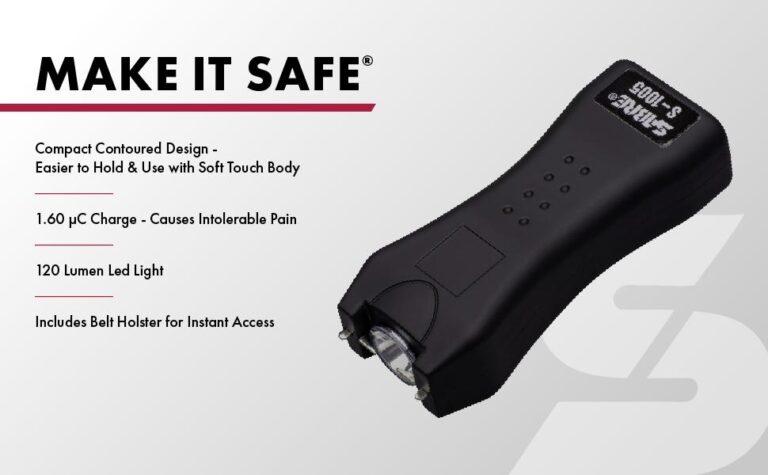Table of Contents
- Understanding the Recommended Duration for Stun Gun Use in Emergency Situations
- Factors Influencing Safe Usage Time of a Stun Gun
- Potential Risks of Prolonged Exposure to Electrical Shock
- Best Practices for Effective and Safe Stun Gun Deployment
- Final Thoughts
Understanding the Recommended Duration for Stun Gun Use in Emergency Situations
When it comes to using a stun gun during a critical incident, timing is everything. Experts generally recommend applying the stun gun for a very brief window – usually no longer than 5 seconds per activation. This short burst is enough to temporarily incapacitate an attacker without causing long-term harm, which aligns with responsible self-defense and legal guidelines in most jurisdictions. Overusing the device not only increases the risk of injury but may also complicate legal scrutiny, so adhering to this recommended duration is essential for both safety and compliance.
Additionally, it’s important to remember that stun guns are designed for quick, decisive moments of defense rather than prolonged confrontations. Best practices include:
- Assess the threat: Use the stun gun only when immediate disengagement from danger is necessary.
- Aim for high-impact areas: Target areas like the torso or thighs where the shock can maximize temporary immobilization.
- Cease use once safe: After the brief shock, move away and seek safety instead of continuing repeated use.
Factors Influencing Safe Usage Time of a Stun Gun
Several key elements determine how long a stun gun can be used safely during an emergency. Device specifications such as voltage, amperage, and battery life directly impact usage time-higher-powered stun guns typically require shorter discharge periods to avoid harm. Additionally, the duration of each stun plays a crucial role; most manufacturers recommend brief bursts lasting only a few seconds to deliver effective incapacitation without causing permanent damage. The user’s familiarity with the device and their ability to control activation durations also influence safety, minimizing risks of overexposure. Environmental conditions, including weather and moisture, can affect the stun gun’s performance and safe operational window as well.
Individual health factors and legal regulations further shape safe usage parameters. For instance, persons with underlying heart conditions or implanted medical devices should exercise caution, as prolonged shocks may amplify health risks. Moreover, varying laws govern stun gun deployment timing across jurisdictions, emphasizing the importance of adhering to local guidelines. Considering these variables, users should prioritize short, controlled bursts over sustained use, ensuring effectiveness while mitigating the chance of injury or legal consequences. Employing proper technique and staying informed about your device’s limits is essential for safe and responsible defense.
Potential Risks of Prolonged Exposure to Electrical Shock
Prolonged exposure to electrical shock from a stun gun can lead to a range of serious health complications. While these devices are designed for short bursts of incapacitation, extending the duration beyond recommended limits increases the risk of cardiac arrhythmias, muscle damage, and even neurological impairments. The body’s nervous system can become overstimulated, potentially resulting in seizures or lasting nerve damage. Moreover, repeated or extended shocks may exacerbate stress on the heart, particularly for individuals with underlying cardiovascular conditions, dramatically raising the danger of life-threatening events.
Beyond immediate physical harm, there are secondary hazards associated with prolonged stun gun use. For instance, if a person loses control due to intense muscle contractions, they may fall or suffer other injuries. Emergency responders and users must remain vigilant about these risks and avoid continuous application. Some subtle but concerning effects may include:
- Severe muscle fatigue and cramps
- Potential respiratory muscle impairment
- Skin burns or irritation at contact points
- Psychological trauma from extended shocks
Best Practices for Effective and Safe Stun Gun Deployment
When confronted with a threatening situation, it’s crucial to use your stun gun with precision and care. Experts recommend applying the device for no longer than 5 seconds per pulse to avoid any potential health risks to the target. Continuous or prolonged exposure can increase the risk of injury or unintended medical complications. After delivering the initial shock, assess the situation immediately – if the aggressor remains a threat, allow a brief pause before deploying another pulse. This controlled application helps preserve safety while ensuring that you retain the upper hand.
To maximize both safety and effectiveness, always follow these practices:
- Maintain a safe distance: Aim for the recommended range specific to your stun gun model, typically 3-7 feet.
- Aim for the torso: Target muscle groups like the abdomen or thighs, avoiding the head or neck to reduce risk of serious injury.
- Use short, controlled bursts: Avoid prolonged continuous shocks, which can cause unnecessary harm.
- Practice regularly: Familiarity with your device ensures faster, more accurate deployment in emergencies.
Final Thoughts
In conclusion, knowing how long to use a stun gun safely during an emergency is crucial for both your safety and the effectiveness of the device. Generally, brief, targeted bursts lasting just a few seconds are sufficient to incapacitate an attacker without causing unnecessary harm. Always follow the manufacturer’s guidelines and local laws, and prioritize de-escalation whenever possible. Remember, a stun gun is a tool for self-defense-not a weapon for prolonged use. Staying informed and practicing responsible usage will help ensure that you are prepared to protect yourself safely and confidently in any emergency situation.Check Our Other Blogs
- StunGun – Your Trusted Source for Stun Guns, Laws, and Self-Defense Tips
- PepperSprayLaws – Your Trusted Resource for Pepper Spray Information
- StunGunLaws – Your Trusted Guide to Stun Gun Legality and Safety





